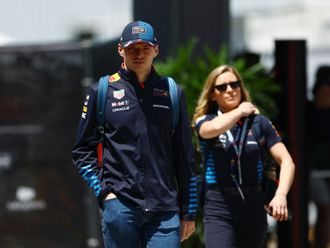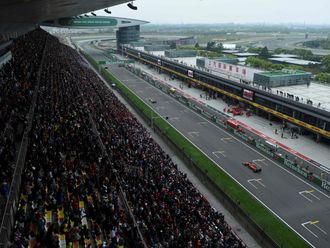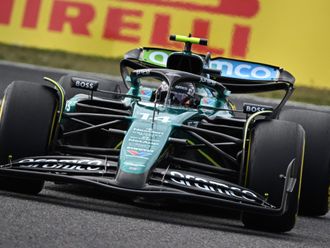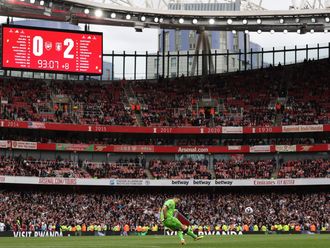
Despite the sophisticated technology invested in a Formula One car, the biggest influence on its performance comes from the four footprints of rubber connecting the car to the racetrack.
The loading through each tyre is so huge — anything up to a tonne of downforce, 4g lateral and 5g longitudinal loading — that F1 rubber bears little relation to the tyres on a road car. There is a technical crossover between the two but the main difference is that a production car tyre is made with heavy steel-belted radial plies and should last for 16,000 kilometres (10,000 miles) or more. An F1 tyre is designed to last for 200 kilometres (124 miles) — at the very most. And, as with everything in F1, the race tyre is constructed to be light and yet strong enough to cope with forces a road tyre would never experience in its lifetime.
Intricate structure
Race tyres have an underlying nylon and polyester structure in a complicated weave pattern, the actual tread being a synthetic cocktail vulcanised together to handle the extreme loads and temperatures of around 100C. Generating the correct temperature is critical — too little and the tyre compound will not offer enough grip, too much and small pieces of rubber will be torn from the tread to cause what is known as graining. In order to keep the tyres at optimum temperature, they are kept in special heat blankets when in the garage. These keep the rubber at 81C and ensure the tyres offer peak performance as soon as the car hits the track.
The racing tyre is constructed from soft rubber compounds that offer the best possible grip against the texture of the racetrack, but wear down quickly in the process. That is why, during a race, the edge of the racing line on the track will become fringed with these tiny pieces of rubber. These are known as marbles, because of their effect should a driver make a misjudgement and run wide in a corner. Dry weather tyres have a smooth surface and are known as slicks. The absence of grooves allows more rubber to make contact with the track surface; indeed, if there was no need to deal with wet roads, production cars would also be fitted with slick tyres for the same reason.
Wet weather tyres
In the event of rain during a grand prix, there are two types of wet weather tyres available; one with deeper grooves (the Wet) than the other (the Intermediate), depending on the amount of standing water on the track. In the case of the Wet, 60 litres of water are expelled by each tyre every second at 300km/h — a colossal performance which allows for maximum contact between the tyre and the track and accounts for drivers being able to race at great speed in appalling conditions. (A road car can only displace about 10 litres of water per second, at much lower speeds). The ‘softness’ or ‘hardness’ of the dry-weather rubber compounds varies according to the characteristics of the track
The actual softness of the tyre rubber is varied by changes in the proportions of ingredients added to the rubber, of which the three main ones are carbon, sulphur and oil. F1 tyres are pressured to around 20psi and filled with a special nitrogen-rich air mixture that helps minimise variations in tyre pressure with temperature.
Slick tyres
Current F1 tyre supplier Pirelli has a range of four dry weather compounds: Super-Soft (red sidewall markings), Soft (yellow markings), Medium (white) and Hard (silver). Two of the four, selected in advance by Pirelli according to circuit characteristics, are available for teams to use at each grand prix. Unless conditions are wet, drivers must use both specifications during the race. The harder tyre is known as the prime tyre, with the softer, quicker but less durable tyre being known as the option.
Managing the life and performance of a set of tyres is a hugely important part of a driver’s role during a grand prix. It is no good being the fastest in the field if, in the process, the driver generates too much heat in the tyres or abuses them unnecessarily by sliding the car excessively while cornering. A crucial moment comes in the event of the safety car appearing and slowing the race while track officials attend to an incident. Running at greatly reduced pace automatically causes tyre temperature to drop and, with it, tyre pressure, thus causing the car to run too close to the ground and ‘bottom out’. The sidewall of the tyre acts as suspension on bumps and kerbs, the tyre actually delivering half of a car’s total suspension travel. A driver must maintain temperature as best he can and, certainly, be aware of a possible change in pressure by the time the safety car is withdrawn and the race restarts.
Racing tyres may appear round and black and relatively straightforward. But in fact, the four circles of rubber at each corner of the car amount to one of its most sophisticated and crucial parts, not just through the manufacturing process but also in the way the driver needs to treat those tyres — with huge respect — if he is to produce an inspired performance.
— Text and pictures courtesy Infiniti












